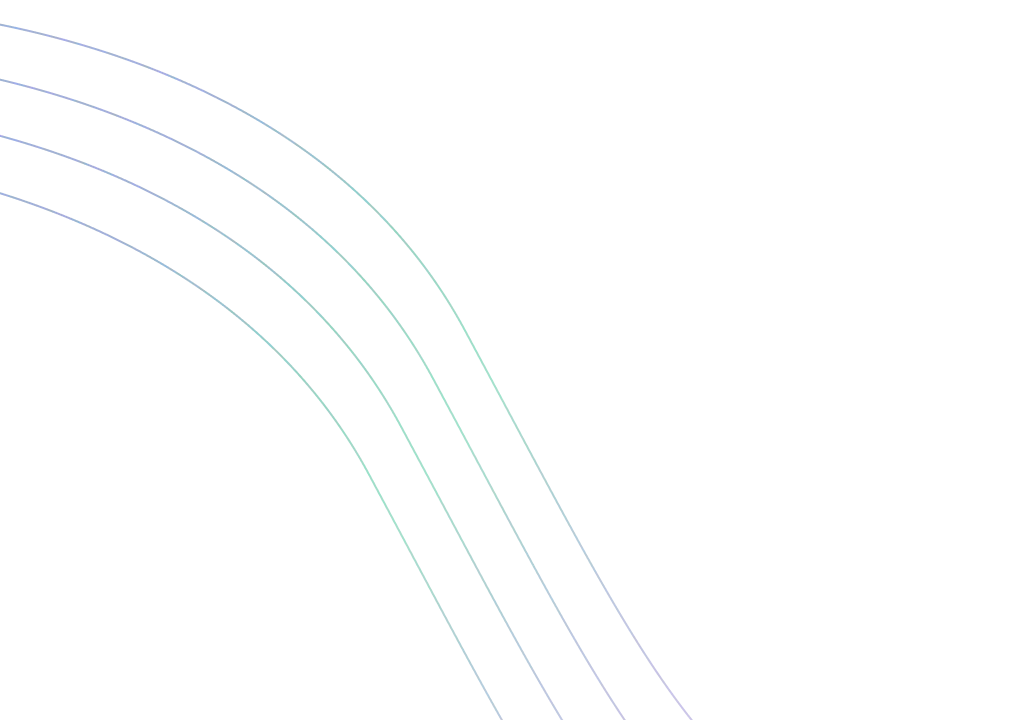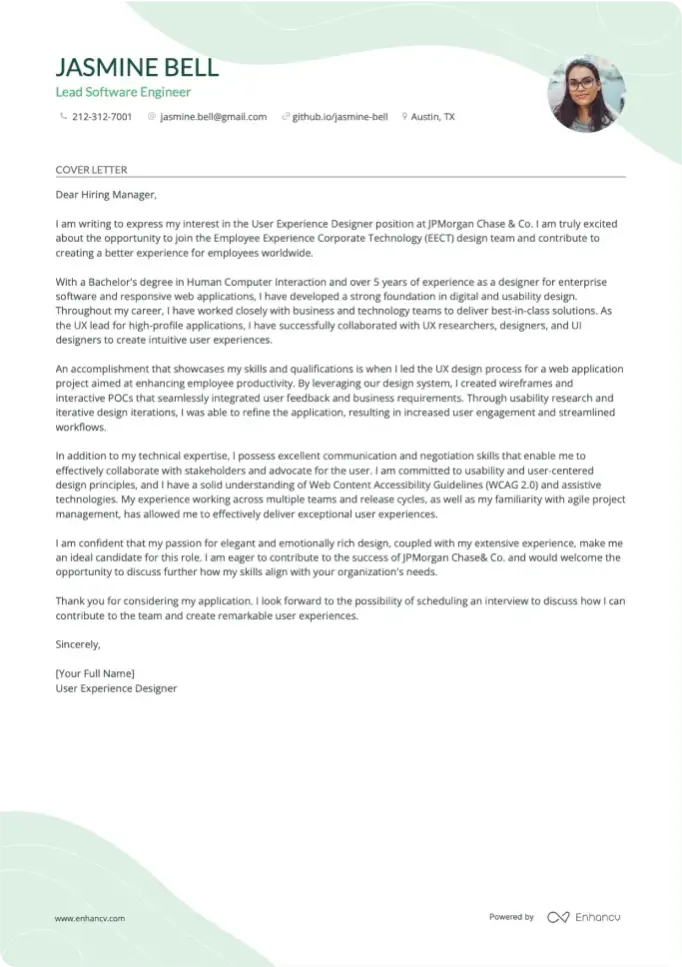As a UX/UI designer, crafting a cover letter can feel like designing with words instead of pixels. You're ready to apply for jobs and realize you need more than a polished resume—your cover letter must resonate. It's not a resume repeat but a one-page narrative showcasing your crowning professional achievement. Strive for a formal tone that's fresh and free of clichés. Let's guide you through writing a cover letter that tells your story compellingly.
- Writing the essential ux ui designer cover letter sections: balancing your professionalism and personality;
- Mixing storytelling, your unique skill set, and your greatest achievement;
- Providing relevant (and interesting) information with your ux ui designer cover letter, despite your lack of professional experience;
- Finding the perfect format for your[ ux ui designer cover letter, using templates from industry experts.
Leverage the power of Enhancv's AI: upload your resume and our platform will map out how your ux ui designer cover letter should look, in mere moments.
If the ux ui designer isn't exactly the one you're looking for we have a plethora of cover letter examples for jobs like this one:
- UX UI Designer resume guide and example
- Creative Graphic Designer cover letter example
- Mold Designer cover letter example
- Concept Art cover letter example
- Web Designer cover letter example
- Video Editor cover letter example
- Senior Art Director cover letter example
- Character Designer cover letter example
- UX Researcher cover letter example
- Electrical Designer cover letter example
- Design Manager cover letter example
Drop your resume here or choose a file.
PDF & DOCX only. Max 2MB file size.
UX UI designer cover letter example
Isabelle Todd
New York, NYC
+1-(234)-555-1234
help@enhancv.com
- Personalization and Company Research: The opening line of the cover letter demonstrates that the candidate has researched the company and appreciates its mission, which shows genuine interest and establishes relevance to the company's values.
- Quantifiable Achievements: The mention of specific metrics, such as the 40% decrease in website bounce rate and the optimization of mobile load speeds, provides concrete evidence of the candidate's impact and expertise in creating a successful user experience.
- Alignment with the Company's Mission: By connecting past work experience with the prospective employer's goals, the candidate shows that her professional philosophy and skills are in line with what the company is looking for in a UI/UX Designer.
- Call to Action: The closing paragraph invites the hiring manager to an interview, clearly expressing the candidate's interest in the role and the desire to discuss her qualifications in more detail, which is an essential component of a strong cover letter.
What should your ux ui designer cover letter look like - formatting and organizing your information
Have you ever wondered what are the must-have sections you need to include in your ux ui designer cover letter? Our builder sets those up for you with:
- Header - dedicated to your contact information, the role you're applying for, and the date (don't forget to include your name);
- Greeting and opening paragraph - to create a personalized and memorable experience for recruiters;
- Body paragraph - emphasizing your skill set and knowledge that aligns with the role and helps you to stand out;
- Closing paragraph - leaving a great impression and ending with an optional signature.
Use a cover letter template to discover the best formatting for your ux ui designer cover letter: that is single-spaced paragraphs and wrapping your content in a one-inch margin.
Ensure that both your resume and ux ui designer cover letter are in the same font. Stand apart from the crowd by using modern, yet simple fonts, like Chivo and Rubik, instead of the overused Arial and Times New Roman.
Did you know that the Applicant Tracker System (or ATS) won't be assessing your ux ui designer cover letter? Instead, submit your profile in PDF to recruiters to keep the same formatting and the design intact.
Writing a cover letter can take time. Skip the hassle with our free cover letter generator and make one in seconds.
The top sections on a ux ui designer cover letter
- Header: Includes your contact information and the date, setting a professional tone for the cover letter, helping the recruiter to easily identify and follow up with you.
- Greeting: It's essential to address the hiring manager or team by name if possible, as personalization can demonstrate your attention to detail—a key skill for a UX/UI designer.
- Introduction: Briefly state your enthusiasm for the role and company, outlining your core UX/UI design experience; this is your hook to engage the reader to continue through your cover letter.
- Body: Highlight specific projects or accomplishments that are relevant to the role you're applying for, showcasing your design process, problem-solving abilities, and user-centered design philosophy that directly relate to UX/UI design.
- Closing: In this section, you should succinctly reaffirm your suitability for the position, express your eagerness to contribute to the company's design goals, and provide a call to action, like an invitation for an interview.
Key qualities recruiters search for in a candidate’s cover letter
- Empathy and user-centric approach: Demonstrates the ability to understand and prioritize user needs and behaviors, ensuring that the final design is intuitive and accessible.
- Mastery of design tools: A strong command of industry-standard design software like Sketch, Adobe Creative Suite, Figma, and InVision shows technical proficiency and the ability to bring ideas to life.
- Knowledge of UX research methodologies: Experience with usability testing, surveys, interviews, and other research techniques proves that the designer can gather and integrate user feedback effectively.
- Understanding of interaction design principles: Showcases an ability to craft engaging interfaces that facilitate smooth user interactions and enhance the overall experience.
- Cross-functional collaboration skills: The ability to work seamlessly with developers, product managers, and other stakeholders is crucial for aligning design with technical constraints and business goals.
- Portfolio showcasing a problem-solving mindset: A well-curated portfolio highlighting previous work, specifically how design challenges were approached and solved, validates the designer's creative and strategic thinking capabilities.
Kick off your ux ui designer cover letter: the salutation or greeting
When writing your ux ui designer cover letter, remember that you're not writing for some complex AI or robot, but for actual human beings.
And recruiters, while on the lookout to understand your experience, would enjoy seeing a cover letter that is tailored to the role and addresses them. Personally.
So, if you haven't done so, invest some time in finding out who's the hiring manager for the role you're applying to. A good place to start would be LinkedIn and the corporate website.
Alternatively, you could also get in touch with the company to find out more information about the role and the name of the recruiter.
If you haven't met the hiring manager, yet, your ux ui designer cover letter salutation should be on a last-name basis (e.g. "Dear Mr. Donaldson" or "Dear Ms. Estephan").
A good old, "Dear HR Professional" (or something along those lines) could work as your last resort if you're struggling to find out the recruiter's name.
List of salutations you can use
- Dear Hiring Manager,
- Dear [Company Name] Team,
- Dear [Department Name] Team,
- Dear Mr./Ms. [Last Name],
- Dear Dr. [Last Name],
- Dear [Title] [Last Name],
How to start your ux ui designer cover letter introduction
The opening paragraph of your ux ui designer cover letter can seem like a real enigma.
Where do you start writing?
In your ux ui designer cover letter introduction, focus on yourself by stating what:
- gets you motivated and excited about the role;
- you like best about the company, from culture to awards.
Write no more than two sentences, which are both authentic and show your enthusiasm for the opportunity.
Structuring your ux ui designer cover letter body to add more value
You've hinted at your value as a professional (this may be your passion for the job or interest in the company) in your introduction.
Next, it's time to pan out the body or middle of your ux ui designer cover letter.
When creating your resume, you've probably gone over the advert a million times to select the most relevant skills.
Well, it's time to repeat this activity. Or just copy and paste your previous list of job-crucial requirements.
Then, select one of your past accomplishments, which is relevant and would impress hiring managers.
Write between three and six paragraphs to focus on the value your professional achievement would bring to your potential, new organization.
Tell a story around your success that ultimately shows off your real value as a professional.
Thinking about the closing paragraph of your ux ui designer cover letter
Before your signature, you have extra space to close off your ux ui designer cover letter.
Use it to either make a promise or look to the future.
Remind recruiters how invaluable of a candidate you are by showing what you plan to achieve in the role.
Also, note your availability for a potential next meeting (in person or over the telephone).
By showing recruiters that you're thinking about the future, you'd come off as both interested in the opportunity and responsible.
The zero experience ux ui designer cover letter: shifting the focus to your unique value
Don't worry if you have no conventional professional experience. Within your whole experience, there's plenty more you can write about in your ux ui designer cover letter.
Take, for example, your biggest achievement or award - dedicate your cover letter body to describe it and the job-relevant skills you've learned.
Your professional ambitions could also take center stage. Describe what you plan on achieving in the next five to ten years and the efforts you're making towards your dreams.
Key takeaways
Winning at your job application game starts with a clear and concise ux ui designer cover letter that:
- Has single-spaced paragraphs, is wrapped in a one-inch margin, and uses the same font as the ux ui designer resume;
- Is personalized to the recruiter (using their name in the greeting) and the role (focusing on your one key achievement that answers job requirements);
- Includes an introduction that helps you stand out and show what value you'd bring to the company;
- Substitutes your lack of experience with an outside-of-work success, that has taught you valuable skills;
- Ends with a call for follow-up or hints at how you'd improve the organization, team, or role.




